apalcillin sodium
- CAS NO.:58795-03-2
- Empirical Formula: C25H22N5NaO6S
- Molecular Weight: 543.52685
- EINECS: 261-446-1
- SAFETY DATA SHEET (SDS)
- Update Date: 2023-05-04 17:34:40
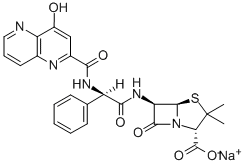
What is apalcillin sodium?
Originator
Lumota,Thomae,W. Germany,1982
The Uses of apalcillin sodium
Antibacterial.
Definition
ChEBI: Apalcillin sodium is an organic sodium salt. It contains an apalcillin(1-).
Manufacturing Process
(a) Preparation of 6-D-α-aminobenzylpenicillin phenacyl ester: To a
suspension of phenacyl 6-aminopenicillanate hydrochloride (1.85 g) and Dphenylglycyl
chloride hydrochloride (1.29 g) in dichloromethane (20 ml),
sodium bicarbonate (1.05 g) was added, and the resultant mixture was stirred while cooling with ice for 6 hours. The reaction mixture was filtered to
eliminate the by-produced sodium chloride. The filtrate was admixed with
isopropanol and concentrated under reduced pressure by the aid of a rotary
evaporator. After the evaporation of dichloromethane, the precipitate was
collected by filtration to give the objective compound in the form of the
hydrochloride (2.19 g) MP 142° to 148°C (decomposition).
(b) Preparation of D-α-(4-hydroxy-1,5-naphthyridine-3-
carbonamido)benzylpenicillin: To a solution of 6-D-α-aminobenzylpenicillin
phenacyl ester (hydrochloride) (2.01 g) and triethylamine (0.808 g) in
dimethylformamide (20 ml), 4-hydroxy-1,5-naphthyridine-3-carboxylic acid Nsuccinimide
ester [MP 310° to 311°C (decomposition)] (1.15 g) was added
while cooling with ice, and the resultant mixture was stirred for 1 hour.
Stirring was further continued at room temperature for 2 hours. After cooling
with ice, 1% sodium bicarbonate solution (100 ml) was added thereto. The
precipitated crystals were collected by filtration, washed with water and dried
over phosphorus pentoxide to give D-(α-4-hydroxy-1,5-naphthyridine-3-
carboxamido)benzylpenicillin phenacyl ester (2.17 g).
The above product was dissolved in dimethylformamide (65 ml), sodium
thiophenoxide (0.89 g) was added thereto, and the resultant mixture was
stirred at room temperature for 1 hour. To the resultant mixture, acetone (650
ml) was added, and the separated crystals were collected by filtration and
washed with acetone and ether in order to give the objective compound in the
form of the sodium salt (1.3 g).
In the above procedure, the use of 4-hydroxy-1,5-naphthyridine-3-carbonyl
chloride in place of 4-hydroxy-1,5-naphthyridine-3-carboxylic acid Nsuccinimide
ester can also afford the same objective compound as above. The
use of sodium thio-n-propoxide in place of sodium thiophenoxide can also give
the objective compound in the form of the sodium salt.
Therapeutic Function
Antibacterial
Safety information for apalcillin sodium
New Products
(S)-3-Aminobutanenitrile hydrochloride 4-Methylphenylacetic acid N-Boc-D-alaninol N-BOC-D/L-ALANINOL Tert-butyl bis(2-chloroethyl)carbamate 3-Morpholino-1-(4-nitrophenyl)-5,6-dihydropyridin- 2(1H)-one Furan-2,5-Dicarboxylic Acid Tropic acid 1-Bromo-3,5-Di-Tert-Butylbenzene S-2-CHLORO PROPIONIC ACID ETHYL ISOCYANOACETATE 2-Bromo-1,3-Bis(Dimethylamino)Trimethinium Hexafluorophosphate 4-IODO BENZOIC ACID 3-NITRO-2-METHYL ANILINE 1-(2,4-DICHLOROPHENYL) ETHANAMINE (2-Hydroxyphenyl)acetonitrile 4-Bromopyrazole 2-(Cyanocyclohexyl)acetic acid 4-methoxy-3,5-dinitropyridine 1-(4-(aminomethyl)benzyl)urea hydrochloride 2-aminopropyl benzoate hydrochloride diethyl 2-(2-((tertbutoxycarbonyl)amino) ethyl)malonate tert-butyl 4- (ureidomethyl)benzylcarbamate Ethyl-2-chloro((4-methoxyphenyl)hydrazono)acetateRelated products of tetrahydrofuran



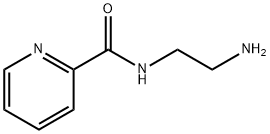
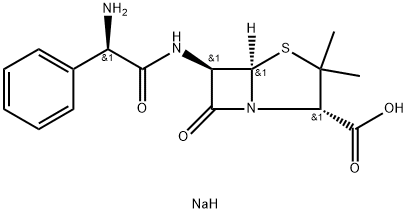
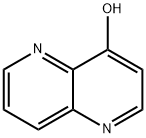
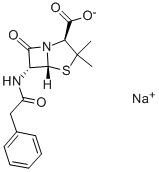

You may like
-
 2033-24-1 98%View Details
2033-24-1 98%View Details
2033-24-1 -
 42831-50-5 5-METHYLISOXAZOLE-4-CARBOXYLIC ACID 98%View Details
42831-50-5 5-METHYLISOXAZOLE-4-CARBOXYLIC ACID 98%View Details
42831-50-5 -
 1975-50-4 98%View Details
1975-50-4 98%View Details
1975-50-4 -
 2-HYDROXY BENZYL ALCOHOL 98%View Details
2-HYDROXY BENZYL ALCOHOL 98%View Details
90-01-7 -
 2-Chloro-1,3-Bis(Dimethylamino)Trimethinium Hexafluorophosphate 221615-75-4 98%View Details
2-Chloro-1,3-Bis(Dimethylamino)Trimethinium Hexafluorophosphate 221615-75-4 98%View Details
221615-75-4 -
 61397-56-6 CIS BROMO BENZOATE 98%View Details
61397-56-6 CIS BROMO BENZOATE 98%View Details
61397-56-6 -
 14714-50-2 (2-Hydroxyphenyl)acetonitrile 98+View Details
14714-50-2 (2-Hydroxyphenyl)acetonitrile 98+View Details
14714-50-2 -
 118753-70-1 98+View Details
118753-70-1 98+View Details
118753-70-1